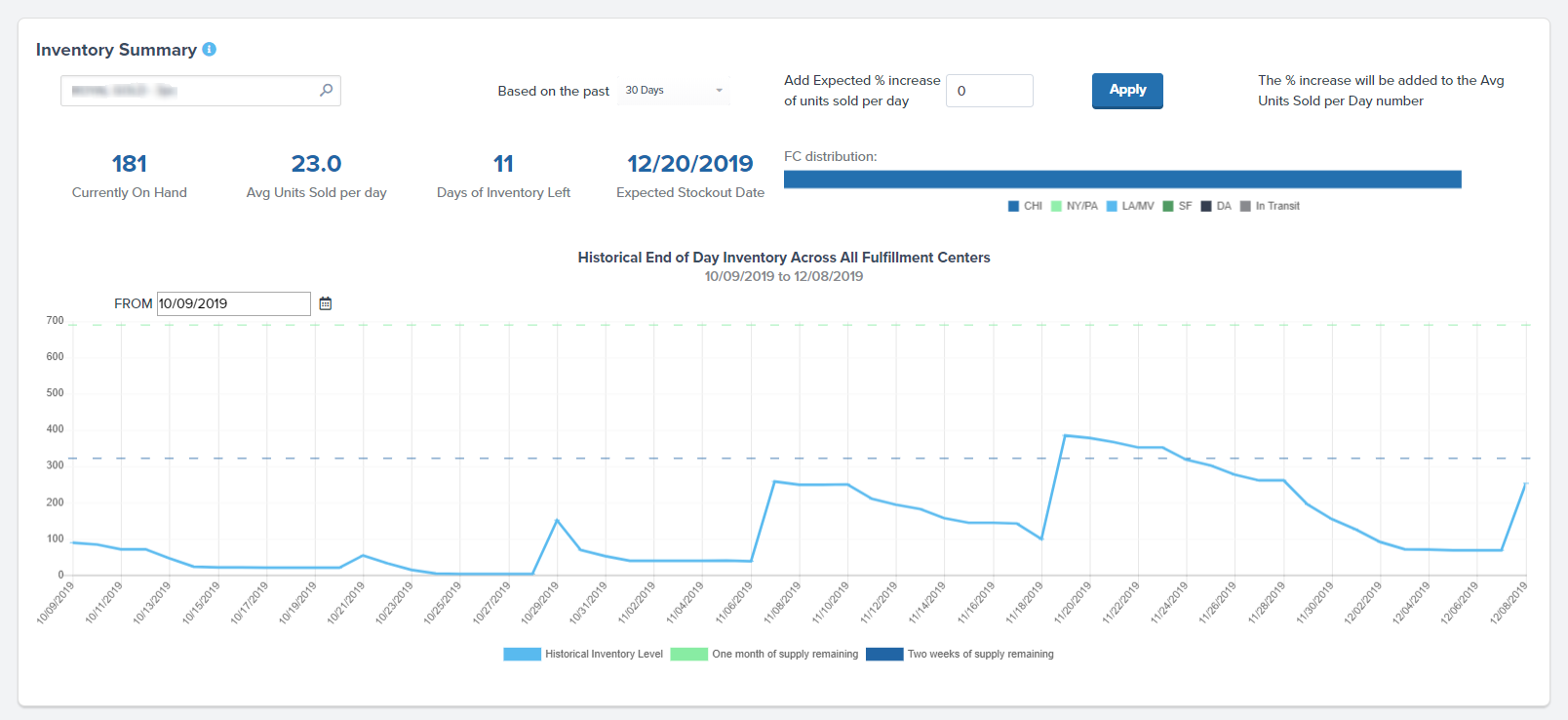Table of Contents
** Minutes
Types of physical inventory often counted
Methods for counting physical inventory
When should you count physical inventory?
Best practices for counting physical inventory
“If you can’t measure it, you can’t improve it.”
This famous quote from Peter Drucker holds true to many things in life and business.
Same goes with managing inventory. If inventory is not regularly updated, tracked, and accounted for, it’s impossible to meet customer demand and maintain an efficient supply chain.
Sure, physical inventory counts can be time-consuming and mundane. But by implementing processes and systems to get a clear picture of stock availability, you can accurately track a high volume of inventory in less time.
In this article, we will discuss why accounting for physical inventory is important, best practices to follow, and how you can outsource fulfilment to make inventory tracking much easier.
What is physical inventory?
Physical inventory is the sellable goods you have on hand and have been counted for by weight, measurement, volume, and/or units.
This type of inventory requires tracking and managing items on the SKU level to ensure that physical inventory counts match inventory records.
Since physical inventory is considered an asset, all inventory must be accounted for at the end of an accounting period.
Physical inventory counts can be done by implementing systems and processes that track inventory levels in real time and use automation to manage the flow of inventory throughout the supply chain, from warehouse receiving to returns management.
Types of physical inventory often counted
The type of inventory you need to keep track of for inventory accounting purposes depends on your business.
In most cases, a direct-to-consumer (DTC) brand is required to track finished goods that are ready to sell to the end customer, whereas a manufacturer is required to keep track of raw materials and items in production.
Here is an overview of the different types of physical inventory that is accounted for throughout the supply chain.
Raw materials
Raw materials (also called production inventory) are unprocessed materials or primary commodities that a manufacturer uses to produce finished products.
In some cases, raw materials can be considered sellable items since they are ready to sell to another business, such as flour and sugar used to make bread; wood, plastic, and metal for furniture production; or bolts of textiles and fabrics for a design house.
Work-in-process
Work in process inventory (WIP) refers to partially manufactured goods that are currently in the production phase. These goods have been altered but not yet reached their finished goods status.
For example, a reusable drinking bottle that is currently being molded using materials like plastic and stainless steel can be considered WIP, because they still need to be painted and packaged before they are sellable.
Finished goods
What’s considered ‘finished goods’ depends on the supplier and the customer. For instance, a seller’s finished goods may become a buyer’s raw materials.
From a DTC perspective, finished goods are an online brand’s most important asset. Finished goods are categorized by SKUs and deemed ready to sell to the end user once they’ve been received by the manufacture or supplier and stored until items are ready to be fulfiled.
By having a handle on finished good inventory and current stock levels, you can track the flow of inventory from what’s been received to what’s been shipped.
MRO supplies
Maintenance, repair, and operations (MRO) refers to the tools and equipment used for the maintenance, repair, and running of production required to manufacture finished goods.
These units are rarely incorporated into the goods being produced, but they are considered inventory items in ecommerce bookkeeping.
Though MRO supplies don’t tie directly with revenue, they are considered a part of your overhead costs and can impact your profit margins.
Methods for counting physical inventory
To count physical inventory, you have two options: manual or automated methods. Either way, counting physical inventory must be done consistently to ensure inventory accuracy at all times.
Here is an overview of the common methods for counting physical inventory.
Manual completion
Manual completion involves physically counting and recording current inventory levels and making updates to records each time there is a change.
You will need to count the value of the inventory you have on hand and divide it by the value of the inventory you are supposed to have based on what you’ve sold and how much you recently ordered.
Conducting manual physical inventory counts can be time-consuming, and there is a high risk of discrepancy and human error, which can impact balance sheets and profit numbers.
Note: If your inventory accuracy is low, you should always consult your sales receipts and records. This could reveal the discrepancy (e.g., you may have sold the missing inventory).
Electronic counting
Today, online retailers are embracing digital inventory solutions by using supply chain technology.
Electronic counting is done with the use of an inventory tracking system or any other type of technology that is designed to enhance visibility by tracking data and collecting information as goods move through the supply chain.
By integrating an inventory management software or a more robust solution like an ERP inventory system, a business can track how much ecommerce inventory is available, where items are located, and how each SKU is performing over time.
Electronic counting methods enable accurate real-time inventory counts, which makes inventory optimisation much easier.
Since many brands don’t have the bandwidth to conduct manual inventory counts, electronic counting is becoming norm and replacing traditional inventory management methods.
“We utilise ShipBob’s Inventory API, which allows us to programmatically retrieve real-time data on how many units of each product are currently stored at ShipBob’s warehouses. We currently use this API to generate custom reports to tie this inventory data into our accounting platforms.”
Cycle counting
Cycle counting is a type of manual method in which inventory is split into more manageable sub-segments (such as location) and physically counted on a recurring basis.
To conduct a cycle count, many businesses use the “ABC classification” method, which consists of faster-moving goods being counted more frequently (e.g., weekly or monthly) than slower-moving goods (e.g., quarterly or annually).
In some cases, higher-value items are prioritised over what’s in high demand, but it ultimately comes down to which inventory has the highest impact on revenue.
The cycle counting method is ideal if you manage a warehouse and don’t want to slow down operations. It helps to cut down the inventory counting process into smaller tasks, reduce operational costs, and make the process much less painful.
When should you count physical inventory?
To decide how often you should count physical inventory, you first need to decide between a perpetual and periodic process.
- Implementing a periodic inventory system requires you to manually update records only after a designated accounting period, therefore inventory counts are not updated after every sale.
- Meanwhile, the perpetual inventory system requires continuous updating of the records with every receipt or sale of goods.
This perpetual inventory method is automatically done via point-of-sale systems, and it is best suited for warehouse inventory managementfor businesses dealing with large inventory volumes.
When to count physical inventory is entirely up to you and your team. However, it’s always best to consult an accountant to make the right decision.
Best practices for counting physical inventory
Counting physical inventory might seem like a daunting task, but there are ways to streamline the process, so that you’re not spending all your time counting inventory and updating records.
Here are some best practices you can easily implement into your inventory management process.
Address discrepancies immediately
Issues like lost or stolen items can lead to inventory shrinkage, while undersold inventory can accumulate what’s known as ‘deadstock‘
Conducting physical inventory counts can help you identify inventory discrepancies sooner than later. Timely inventory reconciliation is key to ensuring that all ecommerce inventory is accounted for.
During the process, if you do come across any discrepancies, you will want to create a “stock reconciliation statement” that explains the discrepancies (if you can) and override your previous records.
Choose staff who are attentive
How attentive and well-trained your staff is will improve the speed and accuracy of the current physical inventory counts.
If you or your team don’t have the bandwidth to manage and track inventory on a consistent basis, you might want to consider partnering with a 3PL to help you optimise the inventory management process while saving your team time.
For instance, ShipBob is a 3PL that uses premium technology to aggregate real-time inventory data and insights.
Once you ship inventory to one or more of ShipBob’s fulfilment locations, you can track real-time inventory levels throughout the order fulfilment process all from one dashboard.
“In terms of tracking inventory, we use ShipBob for everything — to be able to track each bottle of perfume, what we have left, and what we’ve shipped, while getting a lot more information on each order. The analytics are super helpful.
We download Excel files from the ShipBob dashboard all the time and use them to analyse everything from cancelations, to examining order weights, to checking on whether ShipBob is shipping orders on time.
Even the way their warehouse receiving orders (WROs) work for sending inventory is very straightforward.”
Ines Guien, Vice President of Operations at Dossier
This way, you can keep track of the flow of inventory, know when to reorder more, and make better predictions on future demand.
Utilise technology like scanners
To improve inventory accuracy, it’s wise to implement an inventory scanner system.
Inventory scanners are wireless, which makes it easy to scan a product wherever it’s stowed using barcodes to identify each SKU type.
By adding a barcode to your product tags or packaging, you can easily track items by SKU, view how much is in stock, and see where every SKU is located in a warehouse.
Use inventory management software
Using inventory management software is worth the investment because it does away with the painfully slow, error-prone, and time-consuming process of manually tracking inventory.
This type of software is designed to automate time-consuming processes and track inventory in real time — even across multiple channels and warehouses.
There are several solutions on the market with different types of capabilities based on your needs, including multichannel inventory management.
But in the case you don’t want to invest more time and money in your own software, you also have the option to partner with a tech-enabled 3PL like ShipBob that offers digital inventory management solutions as part of their fulfilment capabilities at no extra cost.
“We are very impressed by ShipBob’s transparency, simplicity, and intuitive dashboard. So many 3PLs have either bad or no front-facing software, making it impossible to keep track of what’s leaving or entering the warehouse.
On the supply chain side, I just throw in what we placed at the factory into a WRO in the ShipBob dashboard, and I can see how many units we have on-hand, what’s incoming, what’s at docks, and so on.
I can see all of those numbers in a few seconds, and it makes life so much easier.”
Harley Abrams, Operations Manager of SuperSpeed Golf, LLC
Automate your physical inventory management & tracking
As your ecommerce business grows and inventory becomes more expensive or challenging to track and manage in-house, it might be time to partner with an ecommerce fulfilment company to support you.
ShipBob is a best-in-class 3PL with premium fulfilment technology. Since our global fulfilment network is powered by the same technology, you can easily manage stock across our network, improve inventory turnover rate and days sales in inventory, and reduce your inventory carrying costs to save your business money.
ShipBob’s built-in inventory management tools make SKU management much easier, allowing you to track, manage, and update SKUs across multiple fulfilment centre locations, which would otherwise be troublesome to track via spreadsheets or multiple dashboards.
“I used to have to pull inventory numbers from three places everyday and move all the disparate data into a spreadsheet. ShipBob has an analytics tab in their dashboard with all of this information, which is great for end-of-month reconciliations.
It’s really nice to not have to operate three 3PLs.
For inventory planning, I love the SKU velocity report, daily average products sold, and knowing how much inventory we have left and how long it will last.
The enhanced visibility is great. Between inventory forecasting tools and the ability to auto-create WROs, we don’t have stockouts much anymore. I sleep better at night.”
Wes Brown, Head of Operations at Black Claw LLC
By offering full visibility across multiple fulfilment centres, you get to access advanced data and analytics that provides insights into:
- Demand forecasting
- SKU velocity
- Inventory allocation
- and more
This level of visibility makes it inventory planning more efficient by giving you the information you need to make informed business decisions, such as how to distribute inventory across our network to reduce shipping costs and speed up transit times.


To learn more about how ShipBob can help you optimise your retail fulfilment process, contact our team by clicking the button below.
Physical inventory FAQs
Here are the most frequently asked questions about physical inventory.
When is physical inventory usually taken?
You can choose to record when stock is sold or received in real-time using automation (a perpetual inventory method), or update records over a specified period of time, and at the end of the accounting period, record the final inventory balance and COGS to determine physical inventory count, known as the periodic inventory method.
How do you keep track of physical inventory?
The traditional method is to record physical inventory counts by conducting frequent inventory audits, but today, online retailers are embracing digital inventory solutions to track inventory in real time and aggregate inventory data in one place.
Technology and automation can help to enhance visibility by tracking data and collecting information as goods move through the supply chain. By integrating an inventory management software or partnering with a tech-enabled 3PL like ShipBob, businesses can easily track how much inventory is available at all times, where items are located, and see how each SKU is performing over time.
What is the purpose of counting physical inventory?
Consistently counting physical inventory ensures that what was accounted for in your warehouse(s) matches inventory records. By conducting frequent physical inventory counts or audits, you can avoid major discrepancies such as inventory shrinkage, and reconcile inventory sooner than later. This way, when the accounting period ends, you have accurate inventory counts to include in your balance sheet.



